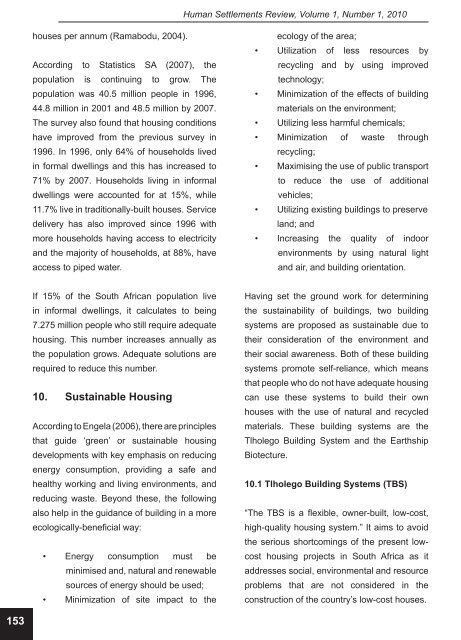Human Settlements Review - Parliamentary Monitoring Group
Human Settlements Review - Parliamentary Monitoring Group
Human Settlements Review - Parliamentary Monitoring Group
Create successful ePaper yourself
Turn your PDF publications into a flip-book with our unique Google optimized e-Paper software.
<strong>Human</strong> <strong>Settlements</strong> <strong>Review</strong>, Volume 1, Number 1, 2010<br />
houses per annum (Ramabodu, 2004).<br />
According to Statistics SA (2007), the<br />
population is continuing to grow. The<br />
population was 40.5 million people in 1996,<br />
44.8 million in 2001 and 48.5 million by 2007.<br />
The survey also found that housing conditions<br />
have improved from the previous survey in<br />
1996. In 1996, only 64% of households lived<br />
in formal dwellings and this has increased to<br />
71% by 2007. Households living in informal<br />
dwellings were accounted for at 15%, while<br />
11.7% live in traditionally-built houses. Service<br />
delivery has also improved since 1996 with<br />
more households having access to electricity<br />
and the majority of households, at 88%, have<br />
access to piped water.<br />
ecology of the area;<br />
• Utilization of less resources by<br />
recycling and by using improved<br />
technology;<br />
• Minimization of the effects of building<br />
materials on the environment;<br />
• Utilizing less harmful chemicals;<br />
• Minimization of waste through<br />
recycling;<br />
• Maximising the use of public transport<br />
to reduce the use of additional<br />
vehicles;<br />
• Utilizing existing buildings to preserve<br />
land; and<br />
• Increasing the quality of indoor<br />
environments by using natural light<br />
and air, and building orientation.<br />
If 15% of the South African population live<br />
in informal dwellings, it calculates to being<br />
7.275 million people who still require adequate<br />
housing. This number increases annually as<br />
the population grows. Adequate solutions are<br />
required to reduce this number.<br />
10. Sustainable Housing<br />
According to Engela (2006), there are principles<br />
that guide ‘green’ or sustainable housing<br />
developments with key emphasis on reducing<br />
energy consumption, providing a safe and<br />
healthy working and living environments, and<br />
reducing waste. Beyond these, the following<br />
also help in the guidance of building in a more<br />
ecologically-beneficial way:<br />
• Energy consumption must be<br />
minimised and, natural and renewable<br />
sources of energy should be used;<br />
• Minimization of site impact to the<br />
Having set the ground work for determining<br />
the sustainability of buildings, two building<br />
systems are proposed as sustainable due to<br />
their consideration of the environment and<br />
their social awareness. Both of these building<br />
systems promote self-reliance, which means<br />
that people who do not have adequate housing<br />
can use these systems to build their own<br />
houses with the use of natural and recycled<br />
materials. These building systems are the<br />
Tlholego Building System and the Earthship<br />
Biotecture.<br />
10.1 Tlholego Building Systems (TBS)<br />
“The TBS is a flexible, owner-built, low-cost,<br />
high-quality housing system.” It aims to avoid<br />
the serious shortcomings of the present lowcost<br />
housing projects in South Africa as it<br />
addresses social, environmental and resource<br />
problems that are not considered in the<br />
construction of the country’s low-cost houses.<br />
153









![National Research Foundation Annual Report 2008 / 2009 [Part 2]](https://img.yumpu.com/49774036/1/177x260/national-research-foundation-annual-report-2008-2009-part-2.jpg?quality=85)







